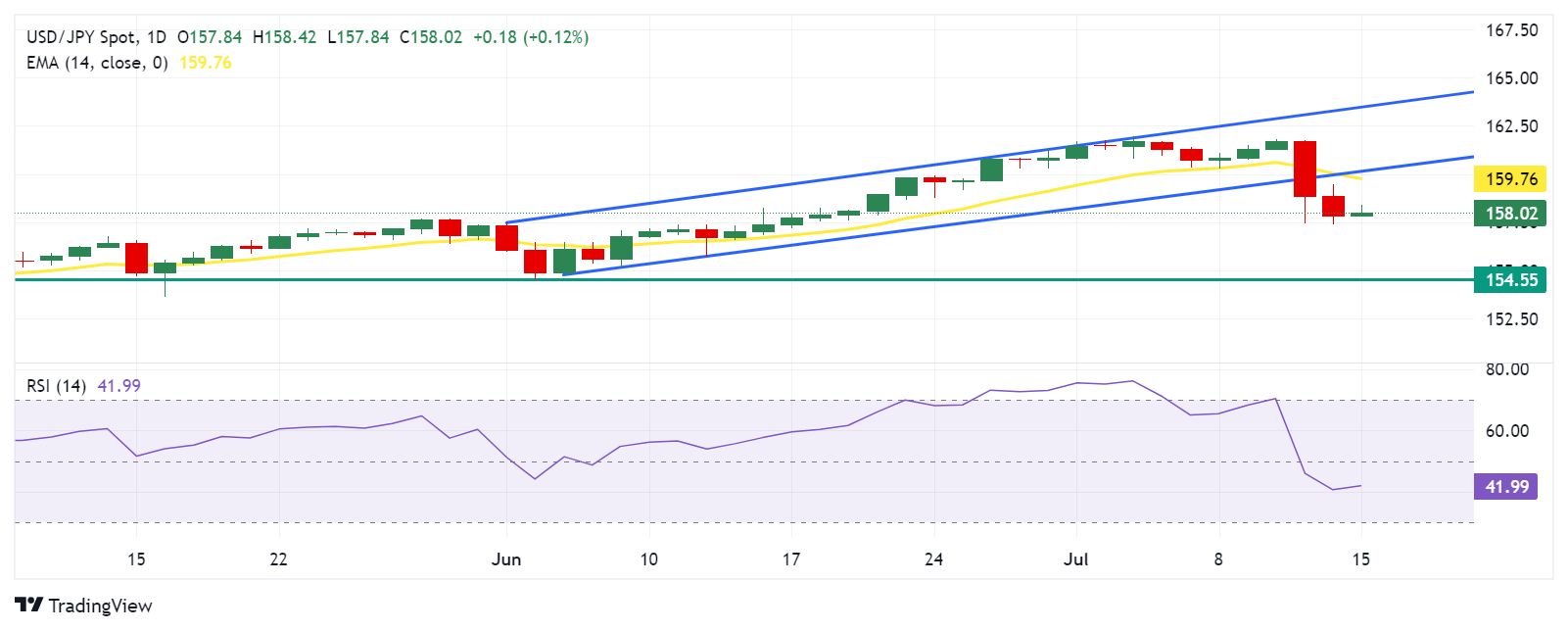- Japanese Yen falls as US Dollar gains on failed assassination of former US President Donald Trump.
- The JPY could experience volatility amid speculation about possible intervention by Japanese authorities.
- Japanese authorities are estimated to have spent between 3.37 trillion yen and 3.57 trillion yen to curb the rapid depreciation of the JPY.
The Japanese Yen (JPY) is down on Monday as the US Dollar (USD) strengthens amid rising risk aversion triggered by the assassination attempt on former US President Donald Trump on Saturday. Analysts speculate that if this event boosts Trump’s chances in the upcoming election, it could boost ‘Trump victory trades’, potentially strengthening the US Dollar and steepening the US Treasury yield curve, according to a Reuters report.
The Japanese Yen (JPY) could face potential volatility amid speculation of intervention by Japanese authorities. According to data released by the Bank of Japan (BoJ) on Friday, it is estimated that Japanese authorities may have spent between 3.37 trillion yen and 3.57 trillion yen on Thursday to stem the rapid depreciation of the JPY, Reuters reported.
The rally in the Japanese Yen, which had been hovering around 38-year lows, began on Thursday as the US Dollar (USD) weakened following data showing a moderation in US consumer prices for June. This development has raised expectations that the Federal Reserve could cut interest rates as early as September.
According to the CME Group’s FedWatch tool, markets now indicate an 88.1% probability of a 25-basis-point rate cut at the Fed’s September meeting, up from 72.2% a week earlier.
Daily Market Wrap: Japanese Yen could experience volatility due to intervention threats
- ING FX analyst Francesco Pesole notes that Japan’s Ministry of Finance has adjusted its FX intervention strategy. Following the release of the US CPI on Friday, the USD/JPY pair fell by approximately 2%, a larger drop compared to other USD pairs. The increase in JPY futures volumes seems to align with indications of FX intervention.
- UBS FX strategists note that speculative investors are holding near-record short positions on the Yen. They suggest that if US economic data continues to signal a soft landing, USD/JPY could experience periods of pullbacks.
- BBH FX strategists note that recent weakness in US data poses challenges to their view that the backdrop of sustained inflation and strong US growth remains largely intact. They point to growing concerns among Federal Reserve officials about weaknesses in the labor market.
- Japan’s Chief Cabinet Secretary Yoshimasa Hayashi has said he is ready to employ all available measures regarding the foreign exchange market. Hayashi said the Bank of Japan (BoJ) would determine the details of monetary policy. He expects the BoJ to implement appropriate measures to sustainably and steadily achieve the 2% price target, Reuters reported on Friday.
- On Friday, Japanese Finance Minister Shunichi Suzuki stressed that rapid movements in the foreign exchange (FX) market are undesirable. Suzuki refrained from commenting on intervention in the FX market and declined to address media reports about Japan’s exchange rate checks, Reuters reported.
- On Thursday, data showed that the US core Consumer Price Index (CPI), which excludes volatile food and energy prices, rose 3.3% year-on-year in June, compared with May’s 3.4% increase and the same expectation. Meanwhile, the core CPI rose 0.1% month-on-month, versus the expected and previous reading of 0.2%.
- Federal Reserve Chairman Jerome Powell stressed the urgent need to monitor the deteriorating labor market on Wednesday. Powell also expressed confidence in the downward trend in inflation, following his comments on Tuesday emphasizing the need for more data to strengthen confidence in the inflation outlook.
Technical Analysis: USD/JPY holds around 158.00
USD/JPY is trading around 158.00 on Monday. The daily chart analysis indicates a weakened uptrend as the pair has broken below the lower boundary of an ascending channel pattern. Moreover, the 14-day Relative Strength Index (RSI) is below the 50 level, signaling a decline in the pair’s momentum.
Further downward movement could put bearish pressure on USD/JPY, potentially testing support near the June low at 154.55.
On the upside, immediate resistance is seen around the 14-day exponential moving average (EMA) at 159.75, followed by the lower boundary of the ascending channel around 160.20. A return to trading within the ascending channel would likely improve sentiment for the USD/JPY pair, with a potential target towards the upper boundary of the ascending channel near 163.50.
USD/JPY: Daily Chart
Japanese Yen PRICE Today
The table below shows the Japanese Yen (JPY) exchange rate against major currencies today. The Japanese Yen was the weakest currency against the British Pound.
| USD | EUR | GBP | JPY | CAD | AUD | NZD | CHF | |
|---|---|---|---|---|---|---|---|---|
| USD | 0.13% | 0.11% | -0.08% | 0.06% | 0.14% | 0.15% | 0.15% | |
| EUR | -0.13% | 0.03% | 0.00% | 0.12% | 0.04% | 0.24% | 0.22% | |
| GBP | -0.11% | -0.03% | 0.06% | 0.10% | 0.02% | 0.15% | 0.20% | |
| JPY | 0.08% | 0.00% | -0.06% | 0.13% | -0.00% | 0.20% | 0.04% | |
| CAD | -0.06% | -0.12% | -0.10% | -0.13% | 0.01% | 0.10% | 0.09% | |
| AUD | -0.14% | -0.04% | -0.02% | 0.00% | -0.01% | 0.17% | 0.20% | |
| NZD | -0.15% | -0.24% | -0.15% | -0.20% | -0.10% | -0.17% | -0.01% | |
| CHF | -0.15% | -0.22% | -0.20% | -0.04% | -0.09% | -0.20% | 0.01% |
The heatmap shows percentage changes of major currencies. The base currency is selected from the left column, while the quote currency is selected from the top row. For example, if you choose the Japanese Yen from the left column and move along the horizontal line to the US Dollar, the percentage change shown in the chart will represent the JPY (base)/USD (quote).
Japanese Yen FAQs
The Japanese Yen (JPY) is one of the most traded currencies in the world. Its value is determined broadly by the performance of the Japanese economy, but more specifically by the policy of the Bank of Japan, the spread between Japanese and US bond yields, and risk sentiment among traders, among other factors.
One of the Bank of Japan’s mandates is currency control, so its moves are key to the Yen. The BoJ has intervened directly in currency markets on occasion, usually to lower the value of the Yen, although it often refrains from doing so due to political concerns of its major trading partners. The BoJ’s current ultra-loose monetary policy, based on massive stimulus to the economy, has caused the Yen to depreciate against its major currency peers. This process has been exacerbated more recently by a growing policy divergence between the BoJ and other major central banks, which have opted to sharply raise interest rates to combat decades-old levels of inflation.
The Bank of Japan’s stance of maintaining an ultra-loose monetary policy has led to an increase in policy divergence with other central banks, in particular with the US Federal Reserve. This favours the widening of the spread between US and Japanese 10-year bonds, which favours the Dollar against the Yen.
The Japanese Yen is often considered a safe haven investment. This means that in times of market stress, investors are more likely to put their money into the Japanese currency due to its perceived reliability and stability. In turbulent times, the Yen is likely to appreciate against other currencies that are considered riskier to invest in.
Source: Fx Street
I am Joshua Winder, a senior-level journalist and editor at World Stock Market. I specialize in covering news related to the stock market and economic trends. With more than 8 years of experience in this field, I have become an expert in financial reporting.








